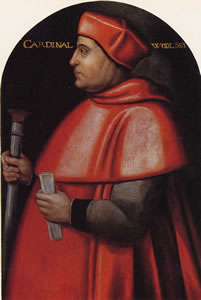Thomas Wolsey
Builder of Hampton Court Palace
c1471 - 1530

Thomas Wolsey was made Archbishop of York in August 1514, a Cardinal and Lord Chancellor in 1515. During that year he also acquired a lease of the estate at Hampton which had been owned by the Knights Hospitaller of St John of Jerusalem since 1237. Here he built a palace befitting his status, the work occupying much of the following decade. It came to be known as Hampton Court Palace. In about 1527 he felt obliged to make the property over to his monarch, Henry VIII, although he was permitted to retain certain apartments for his own use. Henry later embarked on ambitious further building work, much of which subsumed Wolsey's building, obscuring its original layout.
A Renaissance PalaceThe building erected by Wolsey attracted considerable attention, admiration and Henry's envy, but its actual plan has only recently been revealed by the inspired research of Jonathan Foyle. Foyle has identified the precisely geometric proportions of the original palace: an arrangement previously unknown in secular buildings in England although commonly used in Italy at that time. He notes: … in a library in Florence I read an original copy of Paolo Cortese's 'De Cardinalatu', published in 1510. It is a compendium of how to be a cardinal of the High Renaissance, and chapter two describes how to design the ideal cardinal's palace. It explained all of Hampton Court's idiosyncrasies in one fell swoop, including the Roman emperors in the central courtyard. If Wolsey had created the same unprecedented series of motifs at Hampton Court by accident, the coincidence would be even more remarkable.Throughout the 1520s, Wolsey used his new residence both for pleasure and for affairs of state. In 1527 he entertained a French delegation with great magnificence and expense. The scale of the celebration was described by his gentleman usher (George Cavendish): 'There was also 14 score beds provided and furnished with all manner of furniture to them belonging, too long particularly here to rehearse.'
Twickenham connections
Shortly after his ordination at Salisbury in 1498 Wolsey was presented to the Rectory of Limington in Somerset. There he came into conflict with law and order as represented by the sheriff, Sir Amias Paulet, who is said by Cavendish to have placed Wolsey in the stocks following a rowdy display at the local fair. At the height of his powers, in 1520, Wolsey retaliated by confining Paulet to his chambers in the Temple for several years on a charge of heresy. Paulet was the ancestor of both Vere Poulett who came to live in Twickenham in 1759 and Lord William Pawlett who lived at Heath House between 1720 and 1729.
There is another somewhat tenuous connection with Twickenham. In the 18th century Horace Walpole was given Wolsey's Cardinal's hat by the Countess of Albemarle, to add to his extraordinary collection of artefacts at Strawberry Hill. The hat is presently owned by Christ Church College in Oxford where it is, perhaps, a fitting memento of the college's foundation in 1525 by Wolsey who christened it Cardinal's College. Curiously, perhaps, this hat, with its broad brim is quite different from those featured in portraits of Wolsey.
Wolsey was stripped of his offices though promised the archbishopric of York again. In April 1530 he went to York expecting to be installed but was summoned back to London to face a charge of high treason. Ill, he travelled south as far as Leicester where he stopped at the Abbey, dying there on 29 November. He had remarked: Had I but served God as diligently as I have served the King, he would have not given me over in my grey hairs, lines paraphrased later by William Shakespeare in Henry VIII, Act III:
Had I but served my God with half the zeal
I served my king, he would not in mine age
Have left me naked to mine enemies.
Further reading:
George Cavendish, The Life and Death of Cardinal Wolsey, (1st 1641) Folio Society, 1962
Simon Thurley, Hampton Court, A Social and Architectural History, Yale University Press, 2003.
Bernard Garside, The Manor Lordship and Great Parks of Hampton Court, 1951




